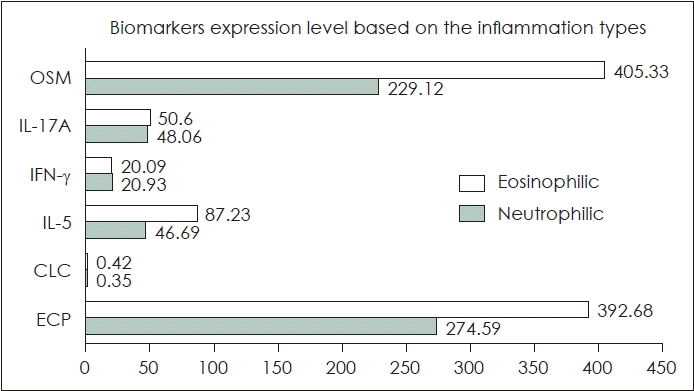1. Rudmik L. Economics of chronic rhinosinusitis. Curr Allergy Asthma Rep. 2017; 17(4):20.

2. Delemarre T, Bochner BS, Simon HU, Bachert C. Rethinking neutrophils and eosinophils in chronic rhinosinusitis. J Allergy Clin Immunol. 2021; 148(2):327–35.

3. Talat R, Speth MM, Gengler I, Phillips KM, Caradonna DS, Gray ST, et al. Chronic rhinosinusitis patients with and without polyps experience different symptom perception and quality of life burdens. Am J Rhinol Allergy. 2020; 34(6):742–50.

4. Kucuksezer UC, Ozdemir C, Akdis M, Akdis CA. Chronic rhinosinusitis: Pathogenesis, therapy options, and more. Expert Opin Pharmacother. 2018; 19(16):1805–15.

5. Liu C, Yan B, Qi S, Zhang Y, Zhang L, Wang C. Predictive significance of Charcot–Leyden crystals for eosinophilic chronic rhinosinusitis with nasal polyps. Am J Rhinol Allergy. 2019; 33(6):671–80.

6. Xu X, Ong YK, Wang Y. Novel findings in immunopathophysiology of chronic rhinosinusitis and their role in a model of precision medicine. Allergy. 2020; 75(4):769–80.

7. Huriyati E, Darwin E, Yanwirasti Y, Wahid I. Differences in expression of inflammatory mediator in mucosal and polyp tissue between chronic rhinosinusitis and recurrent chronic rhinosinusitis. Open Access Maced J Med Sci. 2019; 7(11):1733–8.

8. Ahern S, Cervin A. Inflammation and endotyping in chronic rhinosinusitis—a paradigm shift. Medicina (Kaunas). 2019; 55(4):95.

9. Wicaksana DA, Suheryanto R, Maharani I. Correlation between β-glucan and neutrophil/eosinophil ratio of paranasal sinus mucosa and blood in the diagnosis of chronic fungal rhinosinusitis. Oman Med J. 2018; 33(5):393–400.

10. Brescia G, Contro G, Ruaro A, Barion U, Frigo AC, Sfriso P, et al. Sex and age-related differences in chronic rhinosinusitis with nasal polyps electing ESS. Am J Otolaryngol. 2022; 43(2):103342.

11. Kato A, Peters AT, Stevens WW, Schleimer RP, Tan BK, Kern RC. Endotypes of chronic rhinosinusitis: Relationships to disease phenotypes, pathogenesis, clinical findings, and treatment approaches. Allergy. 2022; 77(3):812–26.

12. Fokkens WJ, Lund VJ, Hopkins C, Hellings PW, Kern R, Reitsma S, et al. Executive summary of EPOS 2020 including integrated care pathways. Rhinology. 2020; 58(2):82–111.

13. Yang LY, Li X, Li WT, Huang JC, Wang ZY, Huang ZZ, et al. Vγ1+ γδT cells are correlated with increasing expression of eosinophil cationic protein and metalloproteinase-7 in chronic rhinosinusitis with nasal polyps inducing the formation of edema. Allergy Asthma Immunol Res. 2017; 9(2):142–51.

14. Bachert C, Zhang N, Hellings PW, Bousquet J. Endotype-driven care pathways in patients with chronic rhinosinusitis. J Allergy Clin Immunol. 2018; 141(5):1543–51.

15. Stevens WW, Ocampo CJ, Berdnikovs S, Sakashita M, Mahdavinia M, Suh L, et al. Cytokines in chronic rhinosinusitis. Role in eosinophilia and aspirin-exacerbated respiratory disease. Am J Respir Crit Care Med. 2015; 192(6):682–94.

16. Lou H, Zhang N, Bachert C, Zhang L. Highlights of eosinophilic chronic rhinosinusitis with nasal polyps in definition, prognosis, and advancement. Int Forum Allergy Rhinol. 2018; 8(11):1218–25.

17. Tan BK, Klingler AI, Poposki JA, Stevens WW, Peters AT, Suh LA, et al. Heterogeneous inflammatory patterns in chronic rhinosinusitis without nasal polyps in Chicago, Illinois. J Allergy Clin Immunol. 2017; 139(2):699–703.e7.

18. Delemarre T, Holtappels G, De Ruyck N, Zhang N, Nauwynck H, Bachert C, et al. A substantial neutrophilic inflammation as regular part of severe type 2 chronic rhinosinusitis with nasal polyps. J Allergy Clin Immunol. 2021; 147(1):179–88.e2.

19. Hoggard M, Waldvogel-Thurlow S, Zoing M, Chang K, Radcliff FJ, Wagner Mackenzie B, et al. Inflammatory endotypes and microbial associations in chronic rhinosinusitis. Front Immunol. 2018; 9:2065.

20. Cho SH, Kim DW, Lee SH, Kolliputi N, Hong SJ, Suh L, et al. Age-related increased prevalence of asthma and nasal polyps in chronic rhinosinusitis and its association with altered IL-6 trans-signaling. Am J Respir Cell Mol Biol. 2015; 53(5):601–6.

21. Kim DK, Kim JY, Han YE, Kim JK, Lim HS, Eun KM, et al. Elastase-positive neutrophils are associated with refractoriness of chronic rhinosinusitis with nasal polyps in an Asian population. Allergy Asthma Immunol Res. 2020; 12(1):42–55.

22. Cao PP, Wang ZC, Schleimer RP, Liu Z. Pathophysiologic mechanisms of chronic rhinosinusitis and their roles in emerging disease endotypes. Ann Allergy Asthma Immunol. 2019; 122(1):33–40.

23. Wang X, Zhang N, Bo M, Holtappels G, Zheng M, Lou H, et al. Diversity of TH cytokine profiles in patients with chronic rhinosinusitis: A multicenter study in Europe, Asia, and Oceania. J Allergy Clin Immunol. 2016; 138(5):1344–53.
24. Pothoven KL, Norton JE, Hulse KE, Suh LA, Carter RG, Rocci E, et al. Oncostatin M promotes mucosal epithelial barrier dysfunction, and its expression is increased in patients with eosinophilic mucosal disease. J Allergy Clin Immunol. 2015; 136(3):737–46.e4.

25. Tian T, Zi X, Peng Y, Wang Z, Hong H, Yan Y, et al. H3N2 influenza virus infection enhances oncostatin M expression in human nasal epithelium. Exp Cell Res. 2018; 371(2):322–9.

26. Poposki JA, Klingler AI, Stevens WW, Suh LA, Tan BK, Peters AT, et al. Elevation of activated neutrophils in chronic rhinosinusitis with nasal polyps. J Allergy Clin Immunol. 2022; 149(5):1666–74.






 PDF
PDF Citation
Citation Print
Print




 XML Download
XML Download